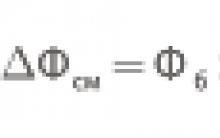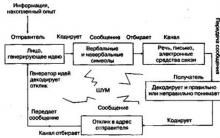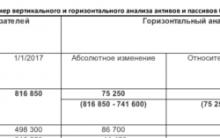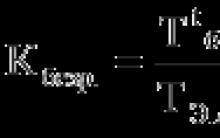According to the survey results building structures a report is drawn up on the technical condition of the building's structures.
In accordance with GOST 31937-2011 "Buildings and structures. Rules for inspection and monitoring of technical condition" there are 4 categories of technical condition of building structures:
- Standard technical condition.
- Working technical condition.
- Limited technical condition.
- Emergency condition.
What is included in the technical report obtained as a result of a building inspection:
Technical report on the results of the building survey
The technical inspection report consists of a text part, photographs, graphic material and applications, and contains the following sections:
1. Title page
Title page includes
full name of the reporting document,
name of the survey object and its location,
the name of the specialized organization performing the work, and
number of the SRO Certificate with permission to this type works,
year of work performed, approval by the head of the specialized organization.
2. Introduction
The "Introduction" section contains:
2.1. justification, information about the organization conducting the technical inspection; customer information; information about the operating organization;
2.2. copies of documents for the right to carry out work
2.3. terms of reference - agreed with the customer, it specifies all the goals and objectives of the survey;
2.4. survey program - agreed with the customer, it describes the stages of the survey work;
2.5. guiding scientific and technical documentation - a list of GOSTs, SPs and SNiPs used during the survey;
2.6. composition of specialists - a list of specialists who carried out the examinations and their qualifications;
2.7. a list of instruments and equipment - with information on the verification of these instruments and equipment.
3. Analysis of technical documentation
In the "Analysis" section technical documentation» provides data on the presence/absence of design technical documentation for a given building (structure), information about the design, construction organizations, BTI passport, results of previous examinations, etc.
4. Results of structural inspection
4.1. General survey data
The section provides a description of the work stages:
preliminary (visual) examination,
detailed (instrumental) examination,
as well as a description of the scope of work.
4.2. Results of visual inspection of building structures
The section provides a description of the building structures of the building (structure), identifies defects and damage, and provides a preliminary assessment of the technical condition of building structures.
4.3. Results of visual inspection of utility networks
The section describes the utility networks present in the building, identifying their defects and damage by external signs.
4.4. Results of a detailed (instrumental) examination
This section provides:
1) actual dimensions between the axes of the main structural elements: spans, column spacing, height marks, distance between nodes;
2) floor plans, sections, facades, roof plan;
3) deviations of overall cross-sectional dimensions and lengths of structural elements from the design ones;
4) actual strength characteristics of basic building materials;
5) defects and damage to elements, assemblies and their arrangement (a defective statement is drawn up if it is necessary to calculate the volume of repair and restoration work).
Depending on the type of building structures, GOST provides for a certain number of works, which in each specific case are determined by the goals and objectives of the survey and may differ from the list above.
6) conclusions from summary descriptions of identified defects and damages, the reasons for their occurrence;
7) conclusion of a technical inspection of the building (structure);
8) recommendations for eliminating identified defects. Recommended measures are indicated to strengthen structures, eliminate defects and damage, and bring them into compliance with the requirements of the normative and technical documentation.
4.5. Results of verification calculations
The section provides the results of verification calculations of structures and their elements
4.6. Roll and draft control
If at visual examination deflections, rolls, settlements, etc. are visible, then this section provides information on the results of measurements of these defects with geodetic instruments.
5. Extract from GOST 31937-2011 "Buildings and structures. Rules for inspection and monitoring of technical condition"
The section provides an extract from GOST with a list of categories of technical condition of building structures.
6. Conclusion on the technical condition of building structures
It is drawn up in accordance with the mandatory Appendix B of GOST 31937-2011 "Buildings and structures. Rules for inspection and monitoring of technical condition."
The section provides an assessment of the technical condition of building structures with justification for the assigned category of technical condition.
The section also provides recommendations for eliminating identified defects and damage, and indicates recommended measures to strengthen structures, eliminate defects and damage, and bring them into compliance with the requirements of the normative and technical documentation.
If the facility is in a limited serviceable or emergency condition, a task is prepared for the design of measures to restore or strengthen the structures.
7. Applications:
7.1.
Photo results
The section contains photographs of the facades, roofs, interiors of the building, defects and damage, pits and openings of structures.
7.2. Copies of qualification certificates
7.3. A copy of the license for software products, used in verification calculations
7.4. Graphic materials
The section provides the results of full-scale measurements of foundations in pits, floor plans, characteristic sections, measurement diagrams, diagrams of the location of defects, drawings of facades, etc. depending on the goals and objectives of the survey.
A technical report with a conclusion on the technical condition of buildings (structures) is signed by the persons who conducted the technical inspection and approved by the head of the specialized organization.
Based on the results of the technical inspection of buildings (structures), measures are developed to eliminate identified deviations from the requirements of regulatory and technical documents, safety requirements and to bring the building (structure) into working condition.
Engineering and technical center "KVALITET" provides services for the inspection of buildings, structures and structures with the preparation of a full technical report.
Conclusion (report) based on the results of the technical inspection is the final document. It must include reasonable answers to all questions posed in the technical inspection task. The text of the conclusion must be written in a clear, understandable language for specialists and fairly concise. Anything that can overload the conclusion with information should be included in the appendices.
Building technical inspection report
The structure of the conclusion may be different. It seems that in its most complete form the text of the conclusion should consist of the following parts:
1. Title page.
2. List of performers.
3. Brief historical information about the object.
4. Characteristics of the constructive solution of the building
or structures.
5. Description of the condition of the structures at the time of the inspection.
6. Conclusions based on the survey results.
7. Recommendations for further operation of the building or structure.
8. List of used literature.
9. Application.
The title page contains the title of the document and details of the organization that conducted the survey.
The list of performers includes all performers of the technical examination, indicating the position, sections and paragraphs of the conclusion in which each of the performers took part, and their signatures.
A brief historical background about the object contains information about the author of the project, construction time, major repairs and reconstruction. This section may contain drawings or photographs of building facades after construction and during the inspection period. It is necessary to note whether the object is an architectural monument.
The Characteristics of a structural solution of a building or structure describes the structural layout of the building or structure, the number of floors, the construction of foundations, walls, floors and coverings, roofing, stairs, balconies, partitions, window and door fillings, floors, appearance finishing works. This section contains floor plans and sections.
In the Description of the state of structures at the time of inspection sequentially, usually starting from the base and foundations, a description of the condition of all structures of the building and structure is given, indicating deviations from the project and all identified defects (technical diagnostics). Inspection reports for individual structural elements are not included in this section of the report. Theirplaced in the application, and links are made to them in the description. This section can contain developments of foundations and walls with cracks on them, areas with high humidity, damaged plaster; plans of floors, coverings and roofing indicating the locations of identified defects. It is better to place photographs of defects and sections along pits in order not to overload the main text of the conclusion in appendices.
At the end of the description of the condition of each structural element (foundations, walls, ceilings, etc.), an assessment of its technical condition and the degree of physical wear (diagnosis) should be given.
Physical wear and tear of structures, buildings or structures is understood as the loss of their original technical and operational qualities.
Physical wear and tear is expressed by the ratio of the cost of necessary repair measures to eliminate damage to structures or the building as a whole, and their replacement cost.
For rate physical wear and tear residential buildings and their structures are available Rules for assessing the physical deterioration of buildings, which can be used to assess the physical deterioration of buildings that are similar in design to residential buildings.
The conclusions based on the survey results should be repeated technical condition assessment each structural element from the previous section of the conclusion and an assessment of the condition of the entire object as a whole (diagnosis), as well as the reasons for the appearance of identified defects.
The Conclusions provide a conclusion about the need to strengthen structures, major renovation, the possibility of reconstructing a building or structure in accordance with the technical inspection assignment. Conclusions are divided into points.
If it is impossible to obtain comprehensive information during the inspection period (due to its short duration), then this part provides a conclusion on the need for further observations of the object (for further deformation of the base, development of cracks, etc.).
If in the task for technical inspection the question is raised about the forecast for the further behavior of the object being examined, then the Conclusions should predict possible changes in the states of the object for a given period (technical forecasting). If in the taskWhen a technical survey asks a question about the state of structures at some point in the past (for example, before an accident), then it must be answered based on an analysis of the survey materials (technical genetics).
In Recommendations for the further operation of a building or structure Suggestions are given on methods for strengthening building structures due to defects identified in them or due to increased loads during the proposed reconstruction of a building or structure. Recommendations should contain proposals for further observations of structures (installation of beacons on cracks, implementation geodetic works to determine the dynamics of development of building deformations, etc.).
 The References list contains a list of normative and reference materials used during the technical inspection (SNiP, manuals, manuals,recommendations, reference books).
The References list contains a list of normative and reference materials used during the technical inspection (SNiP, manuals, manuals,recommendations, reference books).
Applications include:
— assignment for technical inspection of a building or structure;
— measuring drawings of a building or structure;
— materials of engineering-geological surveys;
— materials of geodetic work;
— certificates of inspection of structures;
— results of testing of materials;
— calculations of the degree of wear and tear of building structures and the entire building as a whole;
— verification calculations of building or structure structures;
— other materials on the basis of which conclusions were drawn and recommendations were made.
During preliminary visual inspections of simple objects, the conclusion based on the results of the technical inspection may be small in volume, but it must contain a brief historical background about the object, a description of the design solution of the building or structure, a description of the state of the structures at the time of the inspection, conclusions and recommendations.
The conclusion (report) based on the results of the technical examination may consist of one volume. If there is a large volume of material in the appendices to the conclusion, it is advisable to present them in the form of a separate volume.
Customer of the examination:Name of object: Enterprise building Catering
Address of the object:
Subject of examination: Conducting a technical inspection, inspection of building structures of the 1st floor of the building
As of ___20__

Moscow 20__
CONTENT
1. General Provisions
2. Technical inspection of buildings and structures, Goal and objectives
7. Conclusion
9. List of used literature
Annex 1.
Verification calculations
1. Verification calculation of a monolithic beam floor taking into account the existing screed
2. Verification calculation of a monolithic beam floor without taking into account the weight of the existing screed
3. Verification calculation monolithic ceiling with steel profiled decking taking into account the existing screed
4. Verification calculation of a monolithic floor with a steel profiled flooring without taking into account the existing screed
Appendix 2.
Photo recording documents
Appendix 3.
Protocols for determining the strength of materials
Appendix 4.
Graphic materials
Appendix 5.
Qualification documents
1. General Provisions
This technical report based on the results of the survey was carried out by PROEKT.RU LLC in accordance with the Customer’s Technical Specifications, based on the results of an inspection of the monolithic concrete floor on that. - 0.100 of the building of a public catering establishment located at the address: During a visual inspection of the building, the detected defects and damage to building structures are divided into 3 hazard categories - A, B and C, in accordance with the signs established by RD 22 - 01.97:
A - defects and damage to particularly critical elements and connections that pose a risk of destruction.
B - defects and damage that do not pose a risk of structural destruction at the time of inspection, but may subsequently cause damage to other elements and components or, if the damage develops, move into category A.
B - defects and damage of a local nature, which, during subsequent development, cannot affect other elements and structures (damage to auxiliary structures, platforms, local deflections and dents of unstressed structures, etc.). The assessment of the technical condition of building structures and the building as a whole was carried out using the following condition categories according to SP 13 - 102 - 2003:
Serviceable condition - a category of technical condition of a building structure or a building and structure as a whole, characterized by the absence of defects and damage that affect the reduction of load-bearing capacity and serviceability. Operable - a category of technical condition in which some of the numerically assessed controlled parameters do not meet the requirements of the design, norms and standards, but existing violations of the requirements, for example, for deformability, and in reinforced concrete and for crack resistance, under these specific operating conditions do not lead to a malfunction , and the bearing capacity of structures, taking into account the influence of existing defects and damage, is ensured. Limited operability is a category of technical condition of structures in which there are defects and damage that have led to some reduction in load-bearing capacity, but there is no danger of sudden destruction and the functioning of the structure is possible by monitoring its condition, duration and operating conditions. Unacceptable condition is a category of technical condition of a building structure or a building and structure as a whole, characterized by a decrease in load-bearing capacity and operational characteristics, in which there is a danger to the occupancy of people and the safety of equipment (safety measures and strengthening of structures are necessary). Emergency condition is a category of technical condition of a building structure or a building and structure as a whole, characterized by damage and deformations indicating the exhaustion of the bearing capacity and the danger of collapse (urgent emergency measures are necessary).
2. Purpose and objectives of the survey
Objectives of the survey:
1. Assessment of the technical condition of floor structures at elevation. - 0.100 building of a public catering establishment and determining the possibility of its long-term operation according to its functional purpose;
2. Determining the possibility of loading the examined floor with a useful, evenly distributed load of 500 kg/m2. The objectives of the survey included:
- checking the load-bearing capacity of the floor for a given load;
- collection and analysis of existing design and technical documentation;
- identification of floor defects;
- identification of the actual design of the floor, deviation from the design solution (if any project documentation) and compliance with SNiP requirements;
- determination of physical and mechanical characteristics of materials used in load-bearing structures;
- assessment of the load-bearing capacity of structural elements based on the actual strength characteristics of materials and loads;
- determination of the possibility of long-term operation of the ceiling according to its functional purpose;
- preparation of a report on the results of the survey.
3. Examination methods, devices and instruments
When examining the building structures, visual and visual-instrumental methods were used. Visible defects of building structures were visually identified: cracks, deformations, displacements of load-bearing elements relative to design positions, etc. Visually and instrumental methods were used to clarify the geometric dimensions of building structures and individual elements, and to study the actual physical and mechanical characteristics of the materials of building structures. To assess the spatial position of the building structures, the requirements of SNiP 3.03.01 - 87 “Load-bearing and enclosing structures” were used. Linear measurements were performed with a DISTO laser rangefinder and a standard tape measure.
4. Information about the documents reviewed during the inspection process
To conduct the survey, the Customer provided the following documentation:
- album KR, developed by __ “Architectural Studio”;
- Certificates of inspection of hidden works (reinforcement of floors, concrete).
5. Characteristics of the design solution of the survey object
Overlapping - technical conclusion based on the survey results
Overlap at elevation - 0.100 m can be conditionally divided into two sections: Section No. 1 - monolithic reinforced concrete ribbed floor, located in the axes “10 - 50 / A - B”. The load-bearing beams are monolithic reinforced concrete, of two standard sizes, installed in increments of 3...6 m. The layout, reinforcement and dimensions of the beams are presented in Appendix 4 “Graphic materials” sheet 1, 2. The drawings were made according to the design data provided by the Customer. The thickness of the monolithic floor flange is 100 mm. The shelf reinforcement is made with reinforcing mesh in the upper and lower zones, with a cell of 200 mm, 10 class A - III. The floor is supported by reinforced concrete frame columns and external reinforced concrete walls; Plot No. 2, the ceiling of the room, which is circular in plan, is monolithic reinforced concrete with permanent formwork made of profiled steel Nastal, arranged on rolled metal beams. The overlap is located on the sides of axes “A” and “10”. Design solution, established based on the results of sounding of structures:

The dimensions of the rolled steel I-beams used in the ceiling in section No. 2 correspond to the standard STO ASChM 20 - 93/ The layout, sections and dimensions of the load-bearing beams are presented in Appendix 4, sheet 1.
6. Strength characteristics of materials
The compressive strength of concrete was determined by the shock impulse method in accordance with GOST 22690 using an electronic device IPS - MG4.01 based on the basic calibration dependencies installed in the software device in combination with individual calibration dependencies obtained by specialists of PROEKT.RU LLC based on the results of similar tests samples using destructive testing methods. The results of determining the strength characteristics of the materials of the main structural elements of the building are given in Table 1.
Table 1
Protocols for determining the strength of structural materials are given in Appendix 3.
7. Conclusion
Based on the inspection of the ceiling at elevation. - 0.100 m set:
Floors
1. The ceiling is monolithic reinforced concrete ribbed in axes “1 - 50/A - B”. The thickness of the overlap is 100 mm. The ceiling of the room, which is round in plan, is monolithic reinforced concrete with permanent formwork made of profiled steel Nastal, arranged on rolled steel beams.
2. As a result of verification calculations (see Appendix 1 “Verification calculations”) of the surveyed sections of floors, the following was established:
- the load-bearing capacity of a monolithic ribbed floor in the axes “10 - 50 / A - B” without taking into account the weight of the screed with a thickness of δ = 12.5 cm is sufficient to absorb the designed loads, including a useful evenly distributed load of 500 kg/m2 (see calculation No. 2). If the weight of the screed is taken into account, the load-bearing capacity of the slab part is not ensured (see calculation No. 1).
- load-bearing capacity of the combined floor from the side of axes “A”, “10” ( monolithic slab on steel I-beams of rolled profile) without taking into account the weight of the screed with a thickness of δ = 12.5 cm is not enough to withstand the designed loads (500 kg/m2) due to the fact that the strength of the monolithic slab is not ensured (see calculation 4). At the same time, the load-bearing capacity of the steel floor beams is ensured even taking into account the weight of the screed (see calculation 3).
- The maximum permissible load on the combined floor located on the side of axes “A”, “10” is q=230 kg/m2; 
Rice. Diagram of maximum moments when applying a payload of 500 kg/m2. Areas of the diagram where sufficient load-bearing capacity of the slab is not ensured are highlighted in the diagram in white and indicated by arrows;
3. No defects or damage to ceilings of categories “A” and “B” were detected. The technical condition of the ceilings is operational.
8. Conclusions based on the survey results
1. As a result of full-scale visual and instrumental examinations of building structures and assemblies of the floor area, the conditions of their operation were identified, the actual strength characteristics of the materials of structural elements were determined, and an assessment of the technical condition was given. The examination showed that, in general, the ceiling and nodes were made in compliance building codes and rules, are not subject to excessive precipitation, deflections, rolls, deformations, cracking (from climatic influences, design loads and other factors), etc.
2. In accordance with the inspection results, the technical condition of the ceiling at elevation. - 0.100 is assessed as workable.
3. The load-bearing capacity of a monolithic ribbed floor in the “A - B / 10 - 50” axes (a rectangular part in plan) is sufficient to withstand the designed loads (including a useful, uniformly distributed load of 500 kg/m2), provided that the leveling screed thickness is removed 12.5 cm.
4. The load-bearing capacity of the combined floor (3/4 of a sector that is circular in plan) will be sufficient to bear the designed loads (including a useful, evenly distributed load of 500 kg/m2) only if the 12.5 cm thick leveling screed is removed and the monolithic floor is reinforced in areas with internal forces exceeding the limit (for the location of these areas, see paragraph 2 of section 7 of this Conclusion).
Previous pages
Construction and installation work is not always completed as expected. Already during the execution process, issues may arise that prevent the customer from relying on the contractor. On the other hand, these may just be empty worries, and not the fault of the contractor. Who is right and who is wrong must be decided by an independent, disinterested party. For starters, this is an expert of independent construction expertise, and for final decision dispute and return of money to the injured party - court.
Let’s figure out what a technical report is and how a specialist’s report differs from expert opinion as determined by the court.
Technical opinion of a specialist
The technical report of an expert engineer in the field of construction is an A4 (less often A3) format document. The volume of the finished Conclusion varies from 20-30 pages for small objects (for example, windows, doors, screeds, apartment bays) to 200-300 sheets for comprehensive inspections of the technical condition of buildings and structures (for example, apartment buildings or warehouses, industrial buildings).
What does a technical report include?
Contents of the conclusion:

 The above-mentioned opinion is SUITABLE for submission to the court. And can be reviewed by a judge to make an objective decision. In some cases, the Conclusion helps resolve the issue pre-trial procedure and avoid spending on legal fees and lawyers. And how much time and nerves are saved!
The above-mentioned opinion is SUITABLE for submission to the court. And can be reviewed by a judge to make an objective decision. In some cases, the Conclusion helps resolve the issue pre-trial procedure and avoid spending on legal fees and lawyers. And how much time and nerves are saved!
Expert opinion as determined by the court (Expert opinion)
During trial the judge may decide to order a judicial construction and technical examination. One of the parties may petition for her appointment by providing letters of guarantee from several independent expert companies to the court’s choice.
A court ruling is sent to the selected organization, which contains clear questions. The engineer will reflect the answers to the questions asked in the so-called Expert opinion.
The composition of the expert report is practically no different from the technical report (see above). And yet there are several subtleties.

In our office you will be met by experts who understand your problem and can write a technical report as competently and openly as possible. In addition, after consulting with an expert, in most cases, you understand the real prospects for proceedings in cases of Customer-Contractor or Customer-Contractor-Court.
Well, this report is a little better...if it’s not a secret, how much does 14 pages of the report cost? From the comments I would like to know how the load-bearing capacities of floors, coverings, lintels and walls were determined. There are no characteristics of wall materials and their thickness.
1. Beton Condtrol - not included in the state. register as a device for measuring strength. And he will not be included - he will be refused. So either IPS or ONYX or Schmidt (from the advanced ones).
The method for determining the strength of materials - impact impulse, rebound - etc. is not specified.
(I didn’t see the verification of instruments and laser tape measure).
2. I did not see the opening of the roof - determining the actual composition of the roofing pie.
3. The serial affiliation of prefabricated reinforced concrete elements has not been determined (where did the load-bearing capacity come from???). You can determine the strength of concrete, reinforcement - open it or determine it with a reinforcement detector - and read or determine the serial affiliation.
4. Verification calculations must be provided, and not just the results.
5. Graphics - excellent (well done).
6. Be modest with conclusions, you need to give fundamental decisions on strengthening.
But in general it’s normal, better than many that you have to work with during reconstruction.
Yes, one more thing - the places for determining the strength of materials and the table of results, what the coefficient of variation, etc. are not indicated.
Conditional report. (if you report the calculations, then 5 iron).
Pros - good graphical part, the list of defects is also excellent.
I couldn’t see the photo recording (I don’t know how to open this strange format for me).
Cons: lack of calculations in the text.
The lack of photographs in the text - if there were some it would be very lively.
It would be nice to provide non-destructive testing certificates.
I didn’t delve into the content.
1. doc and dwg format. Why is it heavy, because of photographic recording.
2. Regarding Beton Condtrol - we will take it into account.
3. We do open the roof, but not always.
4. We prepare verification calculations at the customer’s request.
5. Why there are no fundamental decisions in the conclusions is because we give freedom to designers in making decisions, we don’t want to limit them.
The report is normal.
Actually, it is not clear for what purpose it was written. Typically, surveyors are invited:
- to find out the real state of affairs (then everything is described too gloomily)
- to get money for repairs (then the focus is on solving problems, and not just describing them).
PS Dismantle brick walls due to their defects - somehow too much - can it be shifted?
Great, but graphics are even more than required....
Now some offices are producing work like this :)
Notes:
1. Introduction: After the “Work Objective”, a Work Program is drawn up.
2. After the conclusions, it is necessary to make a decision - ABOUT THE TECHNICAL CONDITION (Section 7).
3. Move section 7 by construct to section 4.
4. Section 8.3. Work to strengthen and eliminate defects in building structures should be supplemented with the words “ACCORDING TO DEVELOPED DESIGN DOCUMENTATION.”
5. Section 7. Conclusion on technical condition should be drawn up on letterhead, according to a standard form developed by the organization conducting the survey.
6. Place the conclusion after the title page.
7. Section 9. The list of references does not correspond to those used in the test part.











What documents are needed for tax deductions on a mortgage?
How to do accounting in retail trade
Do I need to file a tax return after selling a car?
What can be attributed to accounting for financial investments?
Plastic compulsory health insurance policy - advantages and disadvantages